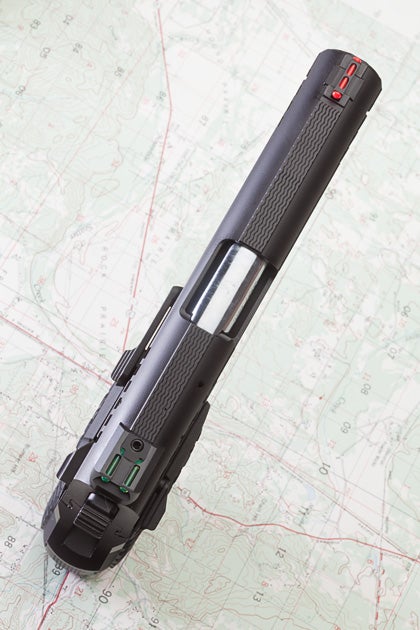Defensive Pistol Sight Options
Oleg Volk 10.07.13

Defensive pistols don’t shoot explosive shells, so close doesn’t count. Precise hits on vitals of opponents are required for effect, so pistol sights have evolved in many different directions. It’s impossible to cover all of them in one article, but we’ll look at the most common examples.
The most obvious option is represented by target pistols: black front and rear for maximum contrast. As such designs go, the Soviet TT33 was decent. The front sight blade was narrow enough to let light around it, and it was possible to get a good sight picture quickly.

That worked well against paper targets, but not in combat. For one, dark sight picture on equally dark target was ineffective. For another, with no detail on the front sight blade, the shooter’s eye tended to focus on the target instead, reducing accuracy. Since then, many new designs have appeared, all trying to make the sights themselves more visible in low light and to make sight alignment more intuitive.

Steyr pyramid pistol sight has higher visibility paint to force front sight focus and a definite center to aid in alignment. The less prominent rear sight is designed to help align the weapon without undue distraction. The down side is that the wide base can obscure the target at longer ranges, but that’s a minor concern for a carry pistol.

This type of sight is robust and simple to manufacture. Paint remains visible so long as the pistol itself is in the light. When the firing is done from darker environment to lighter, only the outlines of the front post and rear notch remain.
Fiber optic inserts amplify available light and make the sights more visible at dusk or indoors, and extremely prominent in daylight. Because the optic rods are fragile, they are usually encapsulated in protective structures.
Some pistols use only front fiber optic sight to draw more attention to it. This approach works but at a cost. The point of impact is lowered slightly whenever the pistol is used in such low light that the fiber optic dot becomes invisible. That’s because the dot resides below the top of the front post, and the top edge is what’s used for elevation alignment when the dot becomes invisible.
For low-light environment, self-luminous tritium sights are superior. The sealed vials of radioactive gas aren’t bright enough for daylight visibility (that’s what the white outlines around them do) but glow on their own at night or indoors. Half-life of tritium is 12 years, in which time the brightness drops by about 50%. The texture created by the inset tritium vial and the outline helps focus the eye on the front post in good light.
Rear sights are either configured the same as fiber optics, two dots on either side of center, or with a single dot to make figure 8 sight picture. This sight is quicker to align horizontally, and the assumption is that vertical alignment is less critical in a defensive situation.

Metallic bead front is another classic type, long-popular on rifles. Budget carbines like Ruger 10-22 use a brass bead, while more upscale LH9 utilizes a brighter, non-tarnishing gold-plated bead.
The metal reflects ambient light proportionally, without glare. This type is simple and durable. It is brighter than paint but less bright than fiber optics.
The rear sight, in this case, is plain black.
Every sight has advantages and disadvantages. Some designs combine more than one technology, for example fiber optics and tritium. For a carry pistol, durability is as important a quality as the clarity of sight picture. Although some people prefer squared-off designs to enable one-handed racking of the slide by pushing against rear sight, most prefer streamlined designs that don’t snag on clothes or holsters, and don’t abrade the shooter’s hands.






